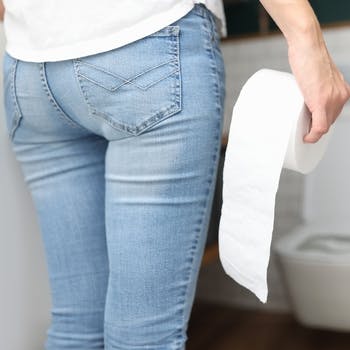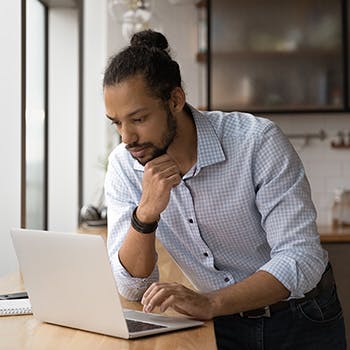Why Are Hemorrhoids Also Called ‘Piles’?

Have you ever wondered why hemorrhoids are often called “piles”? You're not alone. Understanding the origins of this term can be a helpful step toward dealing with your discomfort. Explore the meaning of the word “piles,” and learn how to find relief if you're experiencing this condition.
Hemorrhoids vs. Piles: What Are Piles?
In general, “piles” and “hemorrhoids” are used to refer to the same condition.1 The word “hemorrhoid” is derived from the Greek words “haema” (blood) and “rhoos” (flowing), while the term “piles” comes from the Latin word “pila” (a ball).2 When discussing this condition, these words are typically used interchangeably.1
However, while the terms "piles" and "hemorrhoids" often have the same meaning in the medical world, there are slight differences between them.3 "Hemorrhoids" can refer to both the normal cushions of blood vessels and supporting tissue at the end of the rectum, as well as the condition when these tissues become enlarged.3 Everyone has hemorrhoids, but they become an issue if they’re swollen or irregular.3 Technically, enlarged hemorrhoids are piles, while hemorrhoids in general are something everyone has.3 However, most medical practitioners simply refer to enlarged hemorrhoids as “hemorrhoids.”2
Why the Term ‘Piles’?
As we learned above, the word “piles” comes from the Latin word meaning “a ball.”2 Hemorrhoids are swollen or enlarged lumps of tissue which loosely resemble the shape of a tiny ball, hence the name “piles.”2,3
What Are Symptoms of Hemorrhoids (Piles)?
Hemorrhoids, or piles, can cause various symptoms, including bleeding during or after a bowel movement. This can be caused by hardened stool or excess straining, which can damage the blood vessels in your butt.3 Other symptoms of hemorrhoids can include:3
- Wetness
- Burning
- Itching
- A feeling of pressure on your butt
- Feeling like you haven’t finished going to the bathroom after a bowel movement
- Unintentionally releasing small amounts of mucus and stool
- Pain
- Cracked skin and other skin injuries near your butt
How Can I Relieve My Symptoms?
Many hemorrhoids (piles) go away on their own after a week or slightly longer.4 However, if your hemorrhoid symptoms are uncomfortable, you can help relieve them with the following:4
- Apply an over-the-counter medication with witch hazel or lidocaine cream.
- Increase your water and fiber intake.
- Soak in a warm sitz bath for 10 to 20 minutes daily.
- Take pain relievers to reduce inflammation.
- Use wet toilet paper, toilet paper with lotion or a flushable wipe to pat yourself clean after going to the bathroom.
- For maximum relief, use Preparation H Medicated Wipes before following up with a Multi-Symptom Cream or Rapid Relief Spray. Use as directed.
Who Is at Risk for Developing Hemorrhoids (Piles)?
Anyone can develop hemorrhoids (piles), including teenagers.4 However, hemorrhoids are uncommon among children as they take time to develop.4 Essentially, hemorrhoids are caused by straining and putting pressure on your butt.4 As a result, individuals who often participate in activities that put pressure on their rectal veins can develop hemorrhoids.4 You may be more at risk for hemorrhoids if you:4
- Are overweight or obese
- Are pregnant
- Eat a low-fiber diet
- Have chronic constipation or diarrhea
- Regularly weightlift
- Spend a lot of time on the toilet
- Strain while going to the bathroom
How Do Hemorrhoids (Piles) Develop?
Hemorrhoids, or piles, can develop due to:4
- Pressure on the pelvis from weight gain or pregnancy.
- Straining too hard during a bowel movement due to constipation.
- Lifting heavy objects or weightlifting.
How Do I Prevent Hemorrhoids (Piles)?
Hemorrhoids, or piles, are common as you age.4 However, there are small steps and lifestyle changes you can make to prevent hard stools and constipation, which are causes of hemorrhoids:4
- Don’t hold in your bowel movements; go to the bathroom when you get the urge.
- Hydrate throughout the day.
- Don’t strain while on the toilet.
- Don’t spend too much time on the toilet.
- Eat a high-fiber diet.
- Stay physically active to keep your bowels moving.
- Only take laxatives or enemas as recommended by your healthcare provider.
Now that you know the difference between hemorrhoids and piles, you’re ready to start treating your symptoms. To learn more about treating piles and hemorrhoids, visit our Butt Hub for all things butt related.



